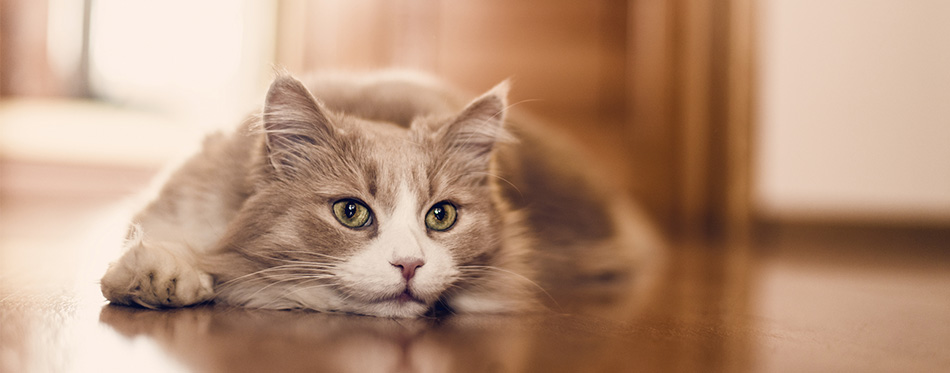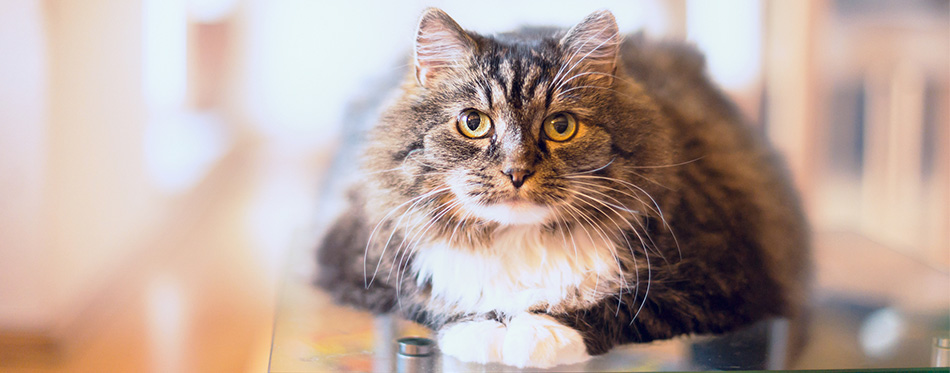Cats, like other living organisms, experience mental decline as they count the years. There is no cure or treatment for senile cat dementia. However, there are certain things you can do to help minimize the impact of cognitive degeneration on their quality of life. This starts with knowledge of the 5 different signs of aging cat dementia.

5 Signs of Senile Dementia in Cats
Cats do not experience Alzheimer’s disease per se. However, they do experience Cognitive Dysfunction Syndrome or CDS. Most of us call this feline senile dementia or aging cat dementia. The cognitive function of cats starts to decline by the time they reach the age of 11 to 12 years. Beyond their 15th year of life, cats will already have feline senile dementia. The symptoms of feline senile dementia can have a profound effect on the organism’s memory and activities of daily living, as well as other cognitive functions.
Disorientation
The brain controls everything. It receives information from the different organs via a system of nerves and neurotransmitters. It integrates or processes these pieces of information to create a more meaningful interpretation. The brain then sends out appropriate signals to the rest of the body. Hence, it is easy to see how a decline in cognitive function can lead to disorientation. In very simple words, the cat’s brain can no longer process the different signals it receives.
One of the telltale signs of aging cat dementia is confusion. It may look confused about certain things. For example, it may no longer be able to navigate its way around the house. The cat no longer knows that it can jump onto the couch or walk around the kitchen center island to get to its food bowl. Sometimes, it also does not know what the food bowl is for.
There are geriatric cats that may bump into things. While this can be the result of a dysfunction in their whiskers and eyes, it may also announce the inability of the brain to process distance information. It is also possible to see a cat staring outside the window for countless hours. It is true that they may admire the beauty of the backyard. But, it can also be due to the brain’s inability to process the information the cat’s eyes are sending it.
Some elderly felines with dementia can also wander. They may go to the backyard and walk around in circles. They no longer know how to enter back in the house through the pet door or an open window. The main concern here is if they pass through an open gate and start wandering around the neighborhood. The chance of the cat getting lost is high.
This is very frightening for many senior felines. As such, they may also increase their vocalizations as a sign of distress. Cats older than 15 years of age meow or yowl with increasing frequency and intensity. Such a behavior is very common during the night. When cats wake up at night and they see nothing but blackness, they feel frightened and confused. Hence, they will increase their vocalizations.
To help your elderly pet, it is crucial to place all the things that it needs in the same exact place every single day. Allowing for easier access to items such as feeding and drinking bowls, beds, and toys can help mitigate the impact of disorientation. Feeding the cat easily-digestible food can help it sleep throughout the night and minimize waking up during sleep. Your supervision is also crucial so you can provide assistance whenever your pet needs some. Check out our guides on cat beds and water bowls for cats for more info.

Increased Soiling or “Accidents” in the House
One of the most pronounced effects of feline disorientation is increased frequency and severity of “accidents” in the house. The cat no longer “knows” how to use its litter box or what it is for. It is also possible that the pet can no longer get to its litter box because it is confused as to where it is.
Of course, disorientation and confusion are not the only things that can account for increased soiling in the home. The brain’s ability to process information can also be an indirect cause. All muscles receive their “commands” from the brain. There are skeletal muscles that can contract and relax at will. However, there are also muscles that receive their “orders” from a branch of the nervous system called the Autonomic Nervous System. The movements of these muscles are involuntary. It means the cat cannot control them at will.
When the cat starts experiencing cognitive decline, it becomes incapable of controlling certain skeletal muscle groups. At the same time, the brain may no longer be able to communicate with its Autonomic branch. This can lead to a partial or complete loss of bladder and bowel control. What this means is that your cat may no longer be able to hold back its bowels or urine.
The urethra contains skeletal muscles that allow it to contract and close the opening. This prevents the passage of urine when the cat does not feel the urge yet. Unfortunately, in cognitive decline, the muscles may no longer contract in an efficient manner. What happens is that urine may leak from the urethra, causing “accidents”. Of course, there are other conditions that can produce urinary incontinence in cats.
As for the feline’s gastrointestinal tract, this contains a combination of skeletal and smooth muscles. The smooth muscles allow for the more effective passage of fecal matter through the colon or large intestines. In the region of the anus, there is a group of muscles that contract to close the orifice. This prevents the passage of the stool when it is not yet time. If there is a problem in the cat’s brain, then it will also not be able to control the passage of stool anymore.
Helping an elderly cat with elimination problems can be tricky. Adding more litter boxes might be a solution in some cases. Putting feline diapers can also address soiling in the house. Putting the litter box in plain sight is a trick that some pet parents also employ.
Changes in Interaction
Some cats love interacting with their owners. This is despite the popular notion that they are independent-minded and would prefer living alone. When a cat grows well-trained and socialized, it can also display many of the behaviors that we consider to be social. They can greet you at the door upon coming home from work. Cats can also relish the times that you snuggle and cuddle with them. Many will also love the interaction that playtime brings.
However, when there is aging cat dementia, you may notice these “social interactions” to become less frequent. The cat doesn’t walk to the door to greet you anymore. It may no longer want to sit on your lap and enjoy moments of cuddling, petting, and snuggling.
This “lack” of interest in social interactions can be due to a declining cognitive function. It is possible that the cat doesn’t recognize you anymore. Your pet is having difficulty remembering who you are and why it needs to greet you at the door. When you try to play with it, the cat does not know how. The interactive cat toys and puzzle feeders that it used to enjoy already mean nothing to the animal. It is not its fault, however. The problem here is the pet is already having difficulty accessing its memory.
Changes in the cat’s social interaction should not prevent you from interacting with it. Your aging cat that has dementia requires more enrichment activities to help slow down the deterioration of its cognitive abilities. However, it is important to introduce changes in the cat’s routine on a gradual basis. Sudden changes can make it more confusing and frightening for the cat. As such, it is best to do it slowly.
Your veterinarian can also prescribe medications to help improve the cat’s cognitive function. As a matter of rule, you can only give psychoactive drugs to your aging pet cat under the strict guidance and supervision of your veterinarian. As effective as these drugs are, they can also present other health problems to your feline friend.
Changes in Sleep Pattern
Confusion and disorientation can also disrupt an elderly cat’s sleep pattern. For us humans, we can call it insomnia. Cats can suffer from insomnia, too. Cat fanciers and feline behaviorists associate this condition with the nocturnal nature of felines. They are most active at dusk because it is that time of day when their prey start going to bed. It is the best time to go on a hunt.
Elderly felines suffering from dementia can have a different reason for their sleep problems. First, they can be very sleepy at daytime because of difficulty sleeping and maintaining sleep at night. As such, it is possible to see an elderly cat to sleep very long hours – often a lot longer than it used to. On the average, a healthy adult cat can sleep anywhere between 12 to 16 hours. On the other hand, cats with senile dementia can get less than 12 hours of sleep.
One has to understand that cats may appear to sleep a lot longer during the day. However, if one has to consider the number of times that they get awakened at night, then it is apparent that they are not getting enough sleep.
There is also the effect of declining brain function on the regulation of the cat’s body clock. Since there is a problem integrating various sensory information, the feline brain can no longer provide precise control of its body rhythm. This can also result in the disruption of the cat’s sleep patterns.
Assisting the cat to sleep better means providing it with more comfortable surroundings. One can also engage the feline pet in moderate exercises before going to sleep. This will help tire it and minimize waking up at night. Your veterinarian can also provide the animal with a sleeping aid to help it feel more relaxed and to sleep better.

Changes in Its Everyday Activities
The combination of disorientation, confusion, loss of bladder and bowel control, and changes in its sleep pattern can have a negative impact on the cat’s daily activities.
The cat may have issues in eating, which can lead to nutritional problems and other health concerns. In general, they may forget to eat. In some cases, they may stare right at their food bowl wondering what it is for or how to eat it. Loss of appetite secondary to feline senile dementia can increase the risk of hepatic lipidosis. This can lead to a host of other problems.
They may not be able to groom themselves anymore. A reduction in self-grooming activities can predispose the aging cat to infections, skin irritation, and other health concerns. The coat can turn dirty and soiled, harboring microorganisms in the process. The skin turns dry and exposes it to irritation and inflammation.
Senile cats may no longer want to play, interact with other cats, or do things that it loved to do when it was still young and full of vigor.
Pet parents of aging cats should give their furry friends high-quality cat food. Supplementation with flavonoids, carnitine, antioxidants, selenium, omega-3 fatty acids, beta-carotene, vitamin C, and vitamin E can also help improve the cat’s cognitive function. Supervising its feeding time helps ensure that your cat is still able to get its much-needed nutrients and energy. If you are looking for more options, check out our guide on vitamins for cats.
Grooming the old cat is a must. This will help maintain the integrity and health of its skin and coat. It will also minimize the risk of skin diseases, coat conditions, and other potential health problems.
Senile dementia in cats is a syndrome that encompasses these 5 key signs. If you have a cat that is already nearing its 15th year of life, you can expect these manifestations to become more profound. A trip to the veterinarian is always a good choice to help you minimize the impact of such conditions on your pet cat’s quality of life.
Sources:
- Cat Dementia: Symptoms, Causes and Treatment – PetMD
- Senility, Dementia or Cognitive Dysfunction Syndrome – International Cat Care

